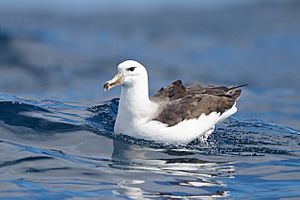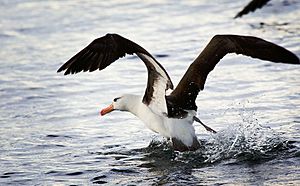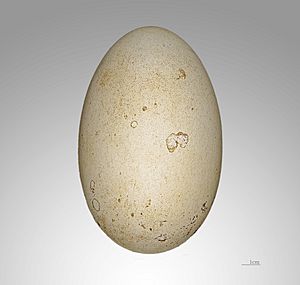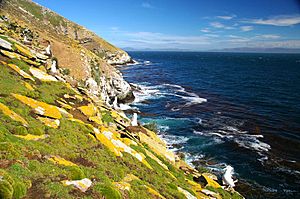Black-browed albatross facts for kids
Quick facts for kids Black-browed albatross |
|
|---|---|
 |
|
| Conservation status | |
| Scientific classification | |
| Genus: |
Thalassarche
|
| Species: |
melanophris
|
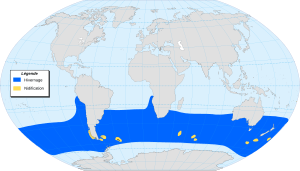 |
|
| Black-browed albatross range | |
| Synonyms | |
|
Diomedea melanophris |
|
The black-browed albatross (Thalassarche melanophris), also known as the black-browed mollymawk, is a large seabird. It belongs to the albatross family, Diomedeidae. This bird is the most common and widespread type of albatross.
Contents
About the Black-browed Albatross
Mollymawks are a type of albatross. Albatrosses are part of a larger group of birds called Procellariiformes. This group also includes birds like shearwaters and petrels. These birds have special features that help them live in the ocean.
For example, they have unique nostrils on the sides of their bills. Their bills are also made of several strong plates. A cool fact about these birds is that they can make a special "stomach oil." This oil is stored in their stomach and is used for two main reasons:
- To protect themselves from predators.
- As a rich food source for their chicks and for themselves during long flights.
Albatrosses also have a special salt gland above their nose. This gland helps them remove extra salt from the ocean water they drink. It gets rid of the salt through their nose as a salty liquid.
The black-browed albatross was first officially described in 1828 by a scientist named Coenraad Jacob Temminck. He studied a bird found near the Cape of Good Hope.
What's in a Name?
The name melanophris comes from two Greek words. Melas or melanos means "black," and ophris means "eyebrow." This name perfectly describes the dark feathers around the bird's eyes, which look like eyebrows.
Appearance of the Black-browed Albatross

The black-browed albatross is a medium-sized albatross. It is about 80 to 95 centimeters (31 to 37 inches) long. Its wings can stretch very wide, from 200 to 240 centimeters (79 to 94 inches). On average, it weighs between 2.9 and 4.7 kilograms (6.4 to 10.4 pounds). These birds can live for a very long time, sometimes over 70 years!
Here's how you can recognize them:
- They have a dark grey back and upper wings.
- Their lower back and belly are white.
- The underside of their wings is mostly white with wide, black edges.
- They have a dark stripe above their eye, which looks like a black eyebrow.
- Their bill is yellow-orange with a darker reddish-orange tip.
Younger albatrosses look a bit different. Their bills are dark horn-colored with dark tips. Their head and neck are grey, and their underwings are dark.
The dark eyebrow and the black edges on the underside of their wings help tell them apart from other similar albatrosses.
Where They Live and Breed
| Location | Population | Date | Trend |
|---|---|---|---|
| Falkland Islands | 399,416 pairs | 2007 | Decreasing 0.7% per year |
| South Georgia Island | 74,296 pairs | 2006 | Decreasing |
| Chile | 122,000 pairs | 2007 | |
| Heard Island | 600 pairs | 1998 | Increasing |
| Total | 600,000 pairs | 2005 | Decreasing |
The black-browed albatross lives all around the southern oceans. They breed on 12 different islands in this area.
Some of their main breeding spots include:
- In the Atlantic Ocean: the Falkland Islands and South Georgia and the South Sandwich Islands.
- In the Pacific Ocean: Campbell Island and Macquarie Island.
- In the Indian Ocean: the Crozet Islands and Kerguelen Islands.
In 2005, it was estimated that there were about 1,220,000 black-browed albatrosses alive. About 600,853 pairs were breeding. The largest number of breeding pairs are found in the Falkland Islands.
These albatrosses like to find food over areas where the ocean floor is not too deep, like continental shelves. Birds from the Falkland Islands often spend winter near the Patagonian Shelf. Birds from South Georgia look for food in South African waters.
Sometimes, a black-browed albatross might fly far off course and end up in unusual places, like the North Atlantic Ocean. There have even been sightings in the Continental United States and in England.
Albatross Behavior

When black-browed albatrosses are in their colonies, they can be very noisy! They make loud braying sounds to mark their space. They also cackle loudly. During courtship, they fan out their tails to impress a mate.
What Do They Eat?
The black-browed albatross eats a variety of things from the ocean. Their diet includes:
- Fish
- Squid
- Crustaceans (like crabs and shrimp)
- Carrion (dead animals)
- Leftover fish from fishing boats.
Sometimes, these clever birds have even been seen stealing food from other bird species!
How They Reproduce
Black-browed albatrosses usually build their nests on steep slopes covered with tussock grass, or sometimes on cliffs. However, on the Falkland Islands, they might nest on flat grassy areas near the coast.
They breed once a year, laying one egg. This usually happens between September 20 and November 1. Both the male and female albatross take turns sitting on the egg. This incubation period lasts for about 68 to 71 days.
After the chick hatches, it takes a long time for it to grow and be ready to fly. Chicks fledge (learn to fly) after 120 to 130 days. Young albatrosses will return to the colony when they are about two or three years old. But they only come back to practice their courtship dances. They usually don't start breeding themselves until they are around 10 years old.
Protecting the Black-browed Albatross
The number of black-browed albatrosses has been decreasing. Because of this, the IUCN once listed this species as endangered. For example, the population on Bird Island was losing 4% of its nesting pairs each year.
The main reason for the decline is increased longline fishing in the southern oceans. Longline fishing uses very long lines with many baited hooks. Albatrosses get caught on these hooks and drown. Trawl fishing also causes many deaths. The black-browed albatross is one of the most common birds killed by fisheries.
To help protect these birds, several efforts are underway:
- The species is listed on the Convention on Migratory Species Appendix II.
- It's also part of the Agreement on the Conservation of Albatrosses and Petrels.
- Scientists are monitoring the birds on many of their breeding islands.
- Most of their breeding sites are now protected reserves.
- Some important breeding islands, like Heard Island and Macquarie Island, are World Heritage Sites.
Rare Sightings (Vagrancy)
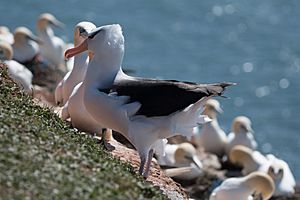
Sometimes, a black-browed albatross gets lost and ends up far from its usual home. For example, one famous albatross, nicknamed Albert, spent many summers living among gannet colonies in Scotland. Scientists believe this was the same bird that was blown off course into the North Atlantic in 1967.
A similar story happened in the Faroe Islands. An albatross lived among gannets there for over 30 years! This is why in the Faroese language, an albatross is sometimes called a "gannet king" (súlukongur).
In recent years, a black-browed albatross (likely Albert) has been seen several times over Heligoland and on the east coast of England. These sightings are very rare and exciting for bird watchers!
Images for kids
-
A black-browed albatross preening its newborn chick on New Island, Falkland Islands.
-
The skeleton of a black-browed albatross at the Museum of Osteology.
See also
 In Spanish: Albatros de ceja negra para niños
In Spanish: Albatros de ceja negra para niños



